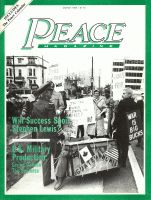ON NOVEMBER 1, 1994, THE Business Council on National Issues (BCNI) released a position paper entitled "Canada's Defence Policy; Capabilities Versus Commitments".
BCNI is composed of the Chief Executive Offices (CEOs) of about 150 major corporations operating in Canada. Members of the task force which produced the position paper include the CEOs of General Foods, the Ford Motor Company, General Mills, Prudential Assurance. Noranda, CAE Industries and ITT. This position paper should not be ignored by the Canadian peace movement, because it will likely affect the policies of the Conservative government.
The paper calls for radical changes in government policies regarding national defence. including:
- "an 80% real increase in defence spending over the next ten years in order to make up fur the deteriorating state of the Canadian military since the late '60s".
- "re-allocation away from other government activities and programs to defence;"
- participation "in the space activities of the United States Armed Forces iii order to ensure that Canadian space and technology industries are able to benefit from a broad range of space-related military development activities" which "promise to have significant commercial implications which cannot be ignored."
- expansion of "Canada's security interests to include the Pacific and Arctic dimensions, the space dimension ... and other strategic areas of the world beyond NATO boundaries;"
- greatly expanded armed forces "which could be available to meet the mobilization requirements beyond the first thirty days of a national and international emergency;" and
- new legislation to permit the government to make graduated responses in crisis situations short of war... as required by crises or the outbreak of hostilities."
The paper also calls for an increase in the regular forces from 82,000 to 115,000, the primary reserves from 20,000 to 61,000. and the supplementary reserves from 17,000 to 25,000.
In advocating these massive increases, however, the paper ironically emphasises the unacceptable destructiveness of hi-tech warfare: "Manpower requirements for the initial day of potential hostilities in Central Europe and the Northern Flank (of NATO) are almost double what Canada now provides. and the reinforcements required for both of these areas in the first thirty days of operations would likely more than exhaust the total pool of trained military personnel in Canada."
The paper has not considered alternatives to the violent kinds of defence that have been used in the past. It would appear that the writers of the document do not really comprehend the awesome destructiveness of modern warfare and so they continue to rely on outdated modes of "defence" which, far from contributing to our safety. endanger it.
Though the paper is unabashed in asking for military spending, it is hesitant to call for more peacekeeping missions. "Once the Canadian Armed Forces have been rebuilt along the lines proposed in this paper, Canada should consider the possibility of expanding its commitments in respect of international peacekeeping operations."
A paper of this importance demands a response The majority of Canadians do not want the kind of militarized economy the paper argues for. Businesses and employees alike have a vested interest in keeping our economy free from creeping (and leaping) militarization The following responses might well be appropriate:
- the creation of a business executive's lobby for peace, disarmament and justice;
- more emphasis on arms conversion campaigns;;
- "pauses for peace" in the workplace:
- active, vocal military tax redirection; and
- greater cooperation among professional organizations devoted to peace.
These activities are a logical response because.'
- nuclear war is bad for business;
- military spending increases unemployment;
- military spending reduces the dollars available to make our lives more enjoyable: and
- the more an economy is militarized, the weaker it becomes.
I suspect that, like most Canadians, most businesspersons do not want increased military spending in Canada. And they can demonstrate their opposition to the proposals of this report by supporting the existing peace movement, by forming their own organizations, and by influencing existing business organizations.
In particular, the importance of arms conversion has become increasingly apparent. Arms conversion is a tool that can be used to demonstrate the waste of military spending, and the process of converting an economy into socially useful production. Unemployment can be reduced through an active arms conversion program, while the quality of our lives can be improved. Canada needs arms conversion, not arms spending.
In addition, each year an ever-increasing portion of our taxes are spent on threatening military programs. It is both hypocritical and unnecessary for us to be working for peace while paying for increases in the military budget. Conscience Canada has created the "Peace Tax Funds In Trust" to hold, in trust for the government, the military portion of the taxes of conscientious objectors to military spending. We can make this trust fund grow by re-directing the military portion of our income taxes to Conscience Canada.
While we could despair at the Business Council's paper, we can also look at it in a positive light. Because the Council has put out this paper, defence and disarmament debates can no
longer be considered taboo in the business world. There will be many, many disagreements with their perspective, and we can look for increased business and corporate involvement in the peace movement. Because disarmament is now a business issue we can more forcefully point out the long-term economic disasters that will accompany increases in our military spending.
Al Rycroft is a software manufacturer in Ottawa and works with INPUT (Initiative for the Peaceful Use of Technology'). For more information about this organization, contact him at Box 248, Station B, Ottawa, Ontario K1P 6C4.



